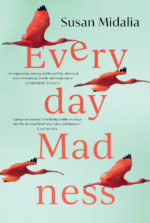From disastrous drafts to finished book: Fremantle Press novelist Susan Midalia on the pleasures and challenges of writing fiction

Susan Midalia is an author, freelance editor, mentor and workshop facilitator with a new novel, Everyday Madness, out this month. In this article she shares what she’s learned from her publication experiences. If you’re a writer yourself, make sure you read her tips at the end of the article.
In this article she shares what she’s learned from her publication experiences. If you’re a writer yourself, make sure you read her tips at the end of the article.
Short stories
I began my writing career as a short story writer. My three collections – A History of the Beanbag, An Unknown Sky and Feet to the Stars – were all shortlisted for major Australian literary awards. So why short stories? Because they pay tribute to moments in our life-in-time: moments which can be profoundly elating or intensely disappointing, turning points or crises; moments that can haunt us, or stay nostalgically nestled in our hearts. I also love writing short stories because they’re a wonderful medium for expressing ‘the unsaid’: the things we cannot, will not or must not say. Short stories remind us that our lives are always a contest between the spoken and the silent, between the surface and what we keep hidden, sometimes from the people who love us, trust us, believe in us.
Writing novels
I’ve published two novels: The Art of Persuasion (2018) and Everyday Madness (2021). I made the switch to novels not because I regard short story writing as an apprenticeship to writing in the longer form, but because I wanted to develop some ideas and characters over a longer period of time. (My first attempt to write a novel was disastrous: having failed to keep a timeline, I discovered to my horror that my main female character had been pregnant for 18 months. She was probably horrified as well.)
One of my writerly pleasures is creating characters markedly different from me. The Art of Persuasion is told from the perspective of 25-year-old Hazel; it combines romance, a political door-knocking campaign and the trials and pleasures of teaching. My new novel, Everyday Madness, is told from the perspectives of four different characters, each with his or her own distinctive voice. I do like a challenge! There’s a middle-aged, cynical, arrogant man; his wife, who becomes clinically depressed; their former daughter-in-law – an over-anxious single mother; and their adolescent granddaughter, who’s funny, smart and estranged from her father. This novel explores a serious mental illness, as well as the various ways in which ordinary people can lose their capacity for rational judgement. It combines pathos, humour and hope – the latter because I’m a great believer in hope. It’s easy to be cynical; it’s much more difficult, and necessary, to believe in people’s ability to change for the better.
Writing about ‘the domestic’
Much of my fiction explores so-called ‘domestic’ experiences: marriage, relationships, family. It’s also often called ‘women’s fiction’. These labels continue to trivialise the ‘domestic’, on the misguided assumption that other issues, such as war or poverty, are more worthy of our attention. But my ‘domestic’ fiction is intended to raise questions about important social and political subjects: the dynamics of power between women and men; changing attitudes to parenting; the destructive effects of traditional ideas about masculinity – ideas that are damaging for men as well as women. I’ve used the subject of personal relationships to consider issues of migration; teaching; terminal illness and grief; the reduction of women to sexualised bodies; how the inability to conceive a baby can affect a marriage, a life. I’ve strived in all my writing to show the wider social and cultural relevance of everyday life. As the American writer Amy Hempel observes, ‘The trick is to find a tiny way into a huge subject.’
Some tips for writers
Read widely, often and attentively. It’s the single most useful thing you can do if you want to be a writer or improve your writing. My first book was published when I was 55, but decades of reading good books – exquisitely written, intelligent, confronting, tender, melancholy books – gave me the best preparation a writer can have. I learned, and continue to learn, so much from reading about the many different ways to narrate and structure a narrative, and the many different possibilities of language.
Write about what you know / don’t know. There’s no rule about this. Do either. Do both. The important thing is to write about what matters to you, because otherwise your work probably won’t matter to readers.
Show, but also tell. There is absolutely nothing wrong with telling readers what to think, as long as what you tell them is interesting and insightful, and is demonstrated by the use of examples. It’s also important not to patronise or lecture readers; the effectiveness of ‘telling’ is partly a matter of tone.
Never compare. Don’t beat yourself up by comparing yourself to much better writers. There will always be thousands of them! Just write, and work to improve your writing.
Work with your strengths, avoid your weaknesses. If you can write, for example, engaging descriptions of setting (it’s not one of my strengths), include that in your work. If you can’t write, for example, convincing dialogue (I can), then don’t: there’s no obligation to have dialogue in a story or novel.
Don’t overwrite. A common problem with less experienced writers is to slather on the adjectives and adverbs, and to use stilted language (‘he opined’ rather than ‘he said’). Good writing isn’t about trying to impress readers with your vocabulary; it’s about communicating an experience in a convincing and engaging way.
Edit, edit and edit again. The writer Ernest Hemingway advised writers to ‘write drunk, edit sober’. So: write without inhibition; write without stopping to criticise your work; just write and see where it takes you. Then, let your work ‘sit’ for a while, and re-read it with a ruthlessly critical perspective. Always read it aloud to eliminate inadvertent repetitions, and to hear whether the sounds of words and the rhythms of sentences achieve the effect you intended. You’ll also hear the pace of your writing: does a paragraph move too slowly? Is a break between paragraphs or chapters too abrupt? You’ll hear whether every word in a sentence is necessary. Even eliminating ‘and’ or ‘but’ can make a clunky sentence sound elegant. Finally, be patient with your work. Always keep in mind another piece of Hemingway advice: ‘The first draft of anything is sh*t.’
Susan Midalia’s novels Everyday Madness and The Art of Persuasion are available in all good bookstores and online.





